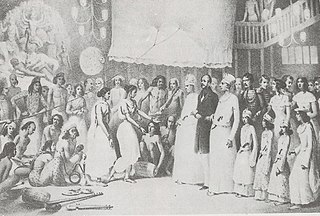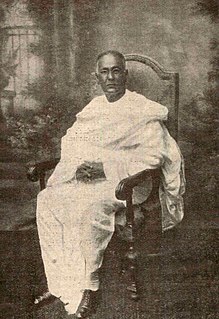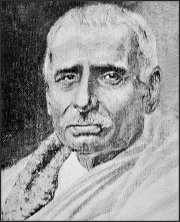
Sachindra Prasad Bose was an Indian independence movement activist and follower of Sir Surendranath Banerjee. He was the son-in-law of the moderate Brahmo leader, Krishna Kumar Mitra.

Rajshekhar Basu, better known by the pen name Parashuram, was a Bengali chemist, author and lexicographer. He was chiefly known for his comic and satirical short stories, and is considered the greatest Bengali humorist of the 20th century. He was awarded the Padma Bhushan in 1956.

Hindu School is a state government-administered school in Kolkata (Calcutta), India. This is the Oldest Modern Educational Institution in Asia. The institution played a key role during Bengal Renaissance period. It is located on College Street, in the vicinity of Hare School, College Square, Presidency University, Sanskrit College, Calcutta Medical College and the University of Calcutta.

Barasat Kalikrishna Girls' High School is a heritage high school for girls in Barasat, West Bengal, India.

Abala, Lady Bose was an Indian social worker and feminist. She was known for her efforts in women's education and her contribution towards helping widows.

Peary Chand Mitra was an Indian writer, journalist, cultural activist and entrepreneur. His pseudo name is Tekchand Thakur. He was a member of Henry Derozio's Young Bengal group, who played a leading role in the Bengal renaissance with the introduction of simple Bengali prose. His Alaler Gharer Dulal pioneered the novel in the Bengali language, leading to a tradition taken up by Bankim Chandra Chatterjee and others. Mitra died on 23 November 1883 in Kolkata.

Maharaja Nabakrishna Deb, founder of the Shovabazar Raj family, was a prominent zamindar and close confidante and ally of Robert Clive. He was the key figure in the plot against Nawab Siraj-ud-Daula although some believed him to be a traitor of India, who sold his motherland to the British and enabling them to rule India.

Bharatchandra Ray Gunakor was an 18th-century Bengali and Sanskrit Sakta court poet and song composer. He is mostly known for his poetic work, Annadamangal or Annapurnamangal. He is often referred to simply as Bharatchandra. Maharaja Krishnachandra of Nadia conferred him with the title Gunakor, after which he became famous as Ray Gunakor Bharatchandra.

Sir Rajendra Nath Mookerjee was a pioneering Bengali Indian industrialist.

Ram Brahma Sanyal was the first Indian superintendent of the Alipore Zoological Gardens in Kolkata. He was a pioneer in captive breeding, and was one of the first zookeepers trained as a biologist. He was a corresponding member of the Zoological Society of London and wrote a handbook on keeping and breeding animals in captivity – A Handbook of the Management of Animals in Captivity in Lower Bengal (1892) which was reviewed in the journal Nature. This was the standard handbook for zookeepers for over 50 years until Lee Crandall published The Management of Wild Mammals in Captivity in 1964. His scientific methods led to the rare birth of a live Sumatran rhinoceros in 1889, an event that was not seen in captivity until 2001.
Hana Catherine Mullens (1826–1861) was a European Christian missionary, educator, translator and writer. She was a leader of zenana missions, setting up schools for girls and writing what is arguably the first novel in Bengali. She spent most of her life in Calcutta, then the capital of British India, and was fluent in the Bengali language.
Deba Prasad Mitra, son of Jyotirindraprasad Mitra (1869–1918), was a renowned clinical pathologist and religious and social worker connected with the Brahmo Samaj. His life and work were greatly inspired and stimulated by the lives of his grandfather Braja Sundar Mitra (1820–1875), the founder of the East Bengal Brahmo Samaj at Dhaka and an inaugurator of the New Age in Dhaka and Eastern Bengal as a whole, and also his mother's grandfather Sib Chandra Deb (1811–1890), a pupil of Henry Louis Vivian Derozio at the Hindu College, the Founder-Secretary of the Sadharan Brahmo Samaj, Kolkata, and pioneer of the modernization of his native village Konnagar, a few kilometers from Kolkata. Devaprasad's father Jyotirindraprasad was a qualified advocate and practiced law for some time, but when he found that one had to resort to falsehood for success in the legal profession, he gave it up and joined the service of the estate of the Tripura Native State at Comilla.

Hara Prasad Shastri, also known as Hara Prasad Bhattacharya, was an Indian academic, Sanskrit scholar, archivist and historian of Bengali literature. He is most known for discovering the Charyapada, the earliest known examples of Bengali literature.

Raja Digambar Mitra (1817–1879) was one of the leading Derozians and first Bengali Sheriff of Kolkata.

Malati Ghoshal was an Indian Rabindra Sangeet singer.

Hemchandra Kanungo Das was an Indian nationalist and a member of the Anushilan Samiti. Kanungo travelled to Paris in 1907, where he learnt the technique of assembling picric acid bombs from exiled Russian revolutionaries. Kanungo's knowledge was disseminated throughout Indian nationalist organisations in the Raj and abroad. In 1908, Kanungo was one of the principal co-accused with Aurobindo Ghosh in the Alipore Bomb Case (1908–09). He was sentenced to transportation for life in the Andamans, but was released in 1921.
The Hindoo Patriot was an English weekly published from Calcutta in the later half of the nineteenth century in Bengal.

Radha Gobinda Kar was an Indian Bengali physician and philanthropist.
Deben Sen was an Indian trade union activist and politician.















